Artemis II Will Send Astronauts Around the Moon
NASA gears up for the world’s first crewed deep-space mission in 50 years
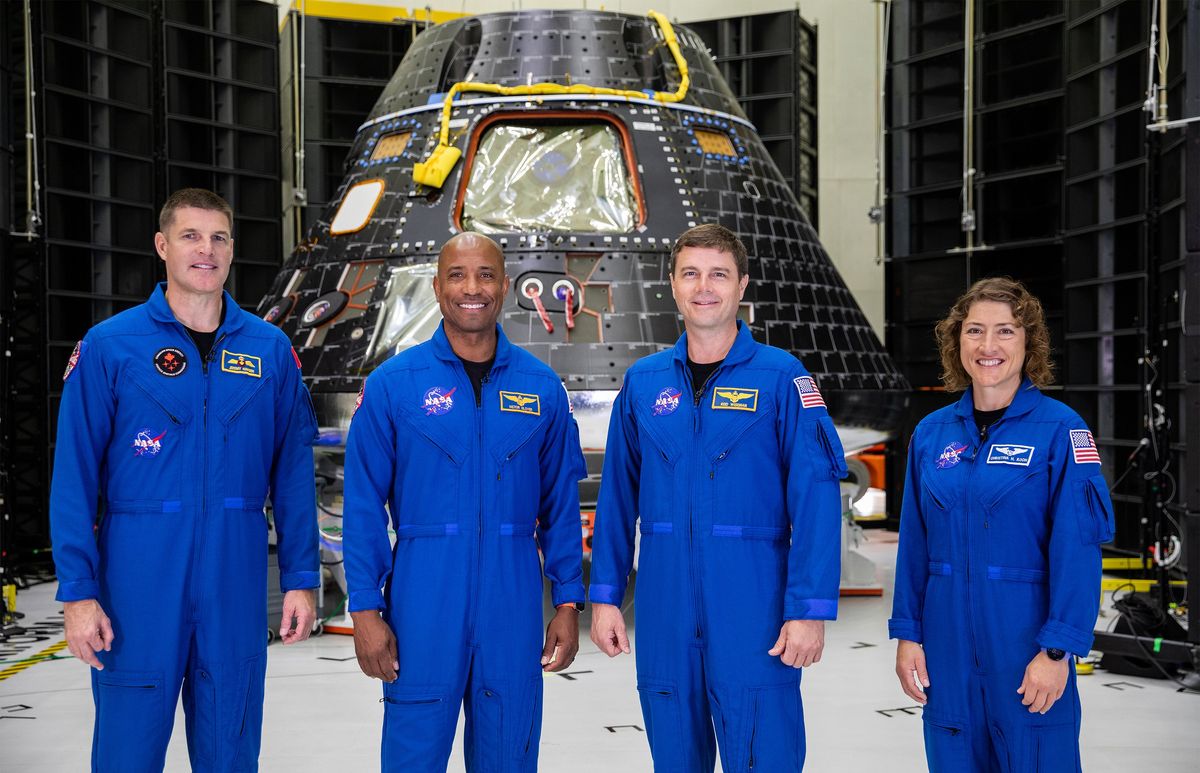
The crew of Artemis II are [from left] Mission Specialist Jeremy Hansen, from Canada, and Pilot Victor J. Glover, Commander Reid Wiseman, and Mission Specialist Christina Koch, all from the United States.
Before the end of this year, four people will climb into a spacecraft, fly to the moon, and swing around it before returning to Earth. Yes, been there, done that. But not for 51 years.
NASA’s Artemis II mission, a warmup for a lunar landing planned for 2025, will mark the first time astronauts have gone beyond low Earth orbit since the Apollo 17 mission, in 1972.
This article is part of our special reportTop Tech 2024.
“It’s a demonstration that the U.S. is recovering technical capabilities it lost two or three generations ago and is on track to returning astronauts to the moon,” says Bleddyn Bowen, associate professor at the University of Leicester, in England. “It will be refreshing to see an actual, crewed mission around the moon after decades of concept art, vague promises, presidential and congressional dithering.”
The 10-day mission, which retraces the 2022 flight of the uncrewed Artemis 1, will test life-support systems. That, in turn, will prepare for the 2025 Artemis III mission, which will land astronauts near the moon’s south pole. The huge Space Launch System (SLS) rocket will send an Orion spacecraft into orbit, the systems will be checked out, the solid-fuel boosters will be jettisoned, and a liquid-propellant rocket will kick Orion into an elliptical high orbit, reaching an apogee of 110,000 kilometers. Then comes the burn for the moon.

The crew will fly 7,400 km beyond the far side of the moon, which it will pass just one time. That way the Orion can use the moon’s gravity as a slingshot to send it on course for its four-day return trip. The crew will experience their own Earthrise, the iconic image from Apollo 8, which though it may lack the profound impact of the original could yet herald a new dawn for exploration.
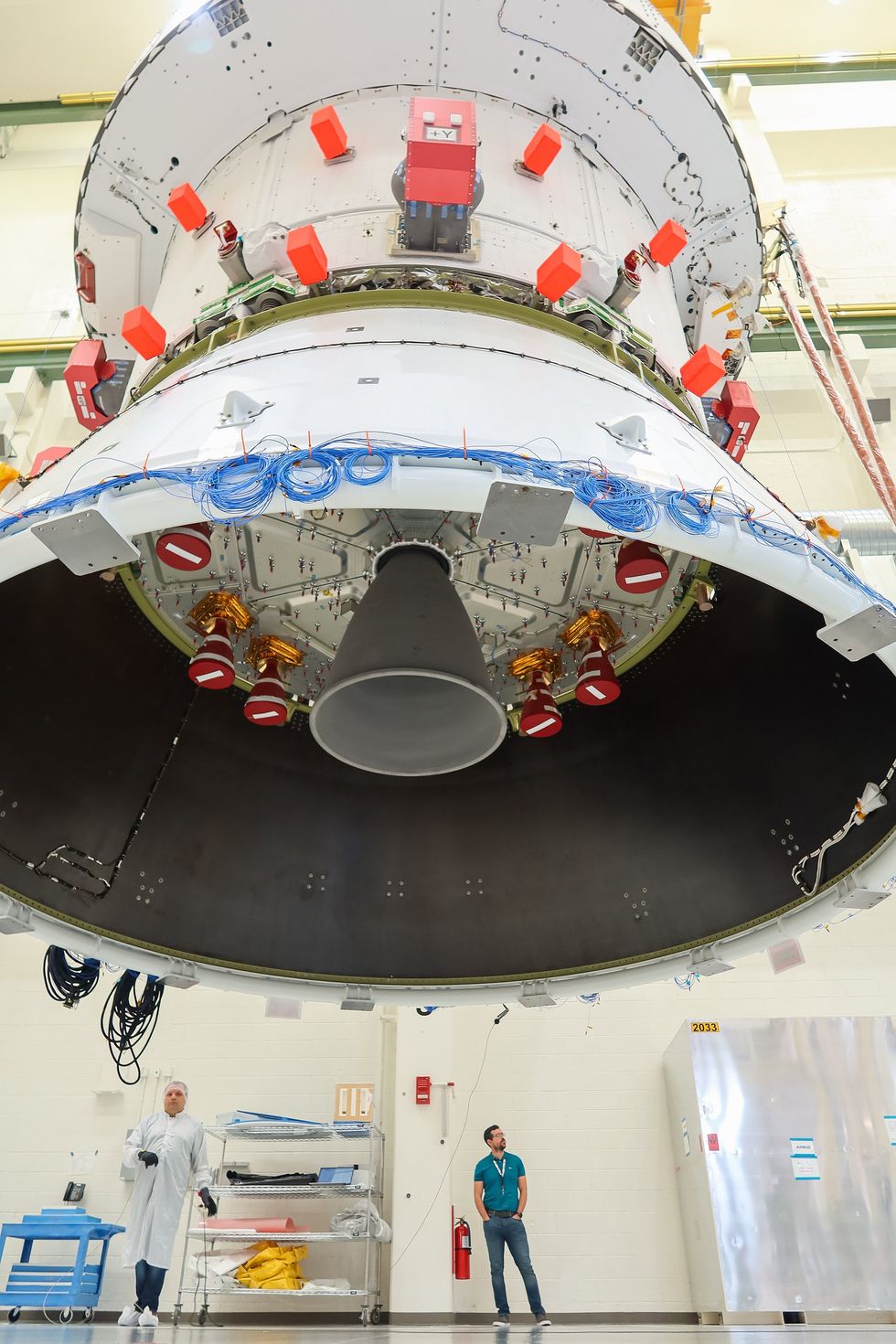
Because of cosmic radiation, travel in deep space requires greater protections and capabilities than those needed for the International Space Station, which orbits just a few hundred kilometers above the earth, within the Earth’s magnetic field. “Orion has been designed to keep humans alive and safe—even during an emergency—hundreds of thousands of miles from home for extended periods, where getting back to Earth takes days to weeks,” says Rachel Kraft, of NASA’s Exploration Systems Development Mission Directorate.
The Lockheed Martin–made Orion and its European Service Module, manufactured by Airbus, pack in more serious radiation protection and radiation-hardened electronics, deep-space guidance, and long-range navigation and control. Along with exercise-equipment and propellant storage, Orion provides nine cubic meters of habitable space, including a bathroom and a galley. It has enough supplies on board to keep a crew alive for three weeks. If the cabin should ever lose air pressure, Orion’s spacesuits can protect and sustain the crew for six days.
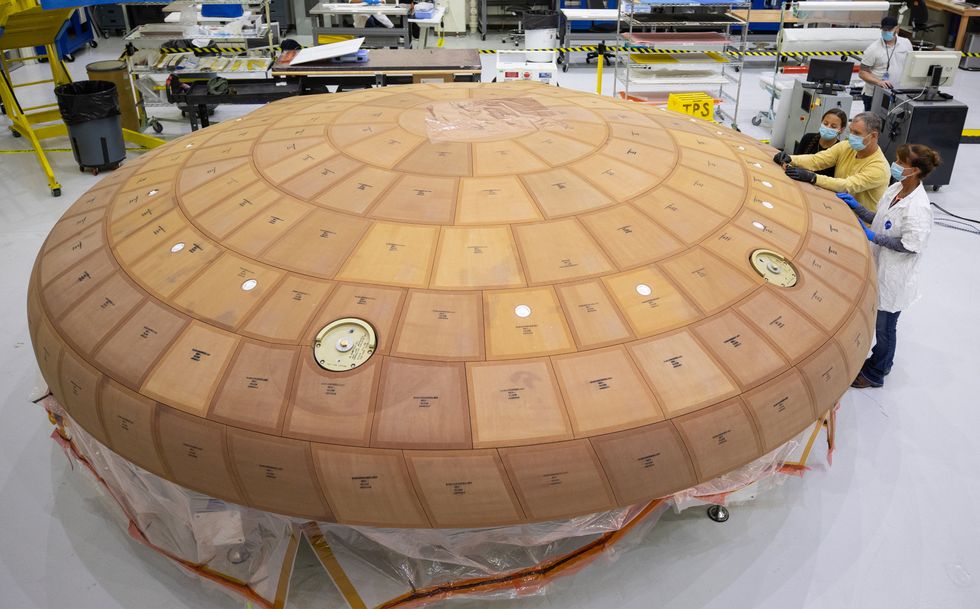
Thermodynamics presents another steep challenge for deep-space travel. A craft returning to the Earth’s surface from low orbit reenters the atmosphere at around 7.8 kilometers per second; one returning from the moon can top 11 km/s, raising the temperature on the leading edge to around 2,800 °C. Orion’s heat shield will cope thanks to its 186 blocks of Avcoat, a material that carries off heat as it gradually burns away.
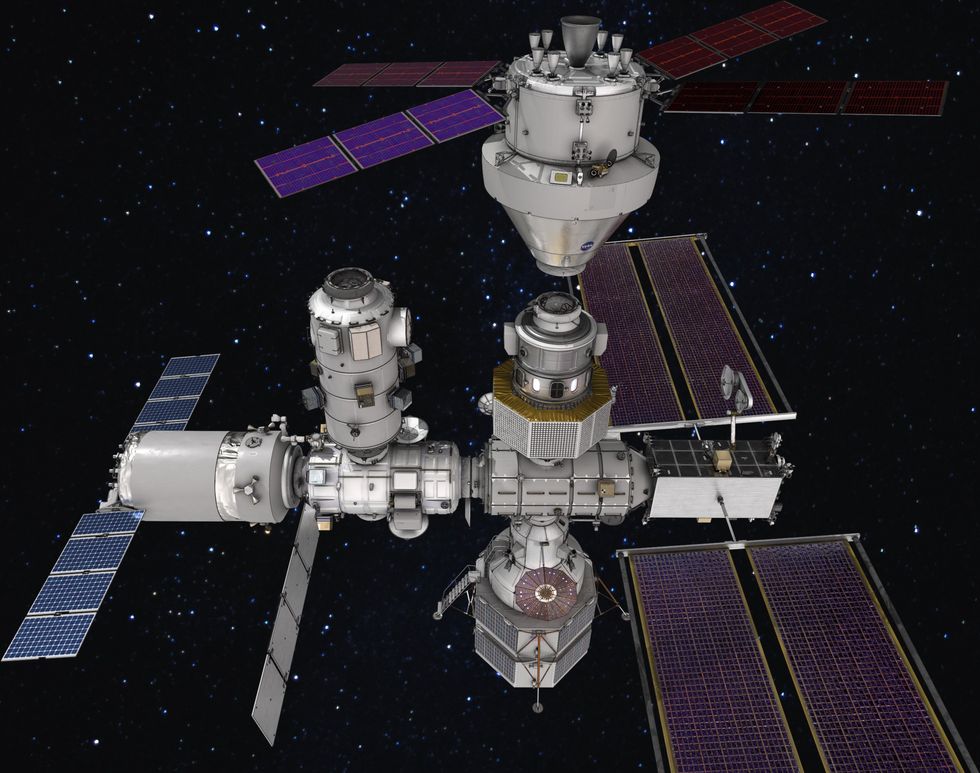
Meanwhile, work is ongoing to make Artemis more than a mere reprise of the Apollo “flags and footprints” visits. Part of this ambition hinges on a lunar orbital station called the Lunar Gateway, a key component of the Artemis architecture. The modular Gateway will be the first space station beyond Earth, providing a place for people to live, conduct science experiments, and refuel for trips to the moon. It will support lunar surface operations and, potentially, provide a staging post for voyages beyond the moon.
Some 25 countries are involved, with NASA taking the leading role. “Coordinating across time zones, borders, and cultures can be challenging,” notes Dylan Connell, a NASA public affairs officer. “But overcoming these obstacles ensures that when the United States goes to the moon this time, we’re going together with our allies.” Such cooperation also requires interoperability standards that extend to the commercial partners in the wider Artemis program.
Who’s Shooting for the Moon?
| Mission | Type | Planned launch |
|---|---|---|
| Queqiao-2 (China) | Relay satellite (+2 cubesats) | March 2024 |
| Chang’e-6 (China) | Sample return | May 2024 |
| IM-2 (Intuitive Machines) | Lander (+hopper, relay satellite, rovers) | Q1, 2024 |
| IM-3 (Intuitive Machines) | Lander (+relay satellite, rovers) | Q2, 2024 |
| Artemis II (NASA) | Crewed circumlunar flight | November 2024 |
| Griffin lander (Astrobotic) | Lander (+NASA VIPER rover) | Late 2024 |
| Hakuto-R 2 (Ispace) | Lander and rover | 2024 |
| DESTINY+ (Japan) | Lunar flyby toward asteroid | 2024 |
According to NASA’s current conception, the eventual mission that will return people to the moon’s surface will start with SLS boosting the Orion spacecraft to a docking with Gateway. There, two of the astronauts will transfer to a Starship Human Landing System, a lunar lander variant of Starship, from SpaceX, for the descent to the lunar surface. After a series of moonwalks, the astronauts will return to the Gateway aboard the Starship, and then travel back to Earth aboard the Orion.
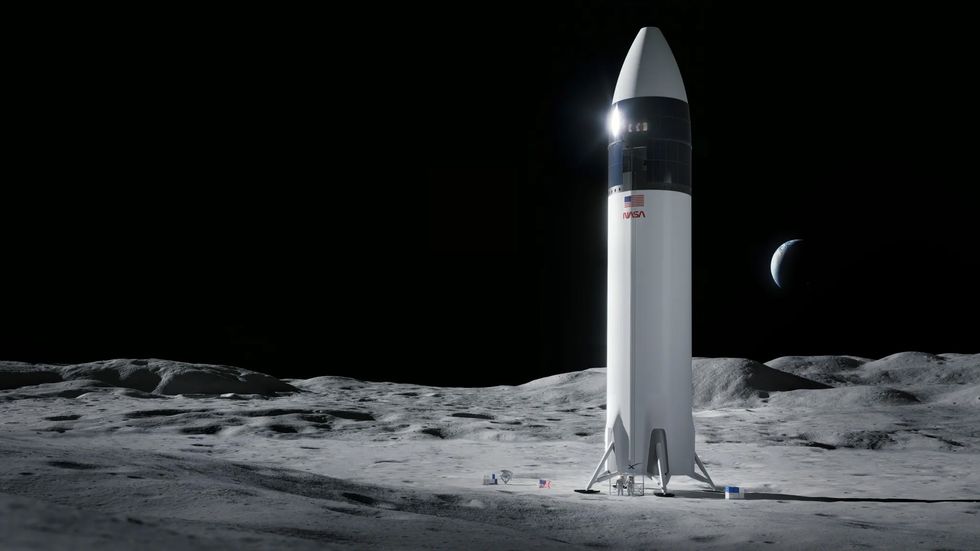
But Gateway has been criticized as an unnecessary complication that could delay a return to the moon. Some analysts have gone so far as to suggest that such a delay could prove advantageous to China, which aims to land two astronauts on the moon before 2030.
Proponents of Gateway point out that it could cost even more to redesign Orion and its service module to allow it to get into and back out of low lunar orbit by using its own main engine instead of docking at Gateway. Nico Dettmann, head of the Lunar Transportation Group within the European Space Agency’s Directorate for Human and Robotic Exploration, says Gateway is an important element in the overall Artemis architecture. “It will allow, amongst other things, sustainable lunar surface missions and know-how for deep-space operations.”
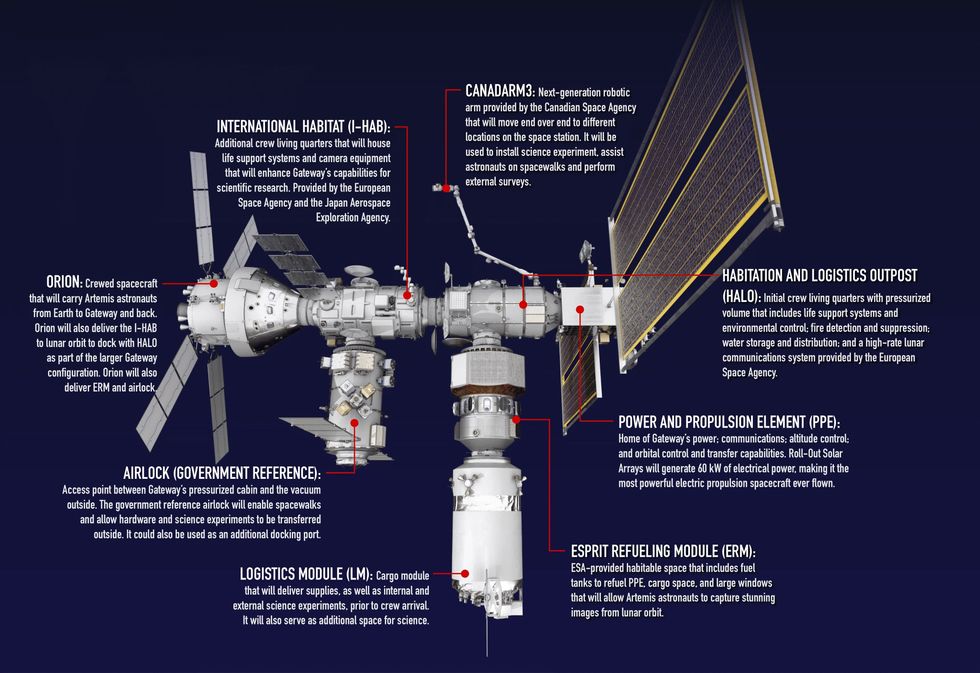
The Lunar Gateway has morphed under the varying pressures of visions and budgets but now its components are nearing launch. The outpost will consist of the Habitation and Logistics Outpost (HALO) built by Northrop Grumman and able to host an Orion crew of four for 30 days. The Power and Propulsion Element (PPE), developed by Maxar Technologies, will provide power and high-rate Ka-band and X-band communications between Gateway and Earth for video and voice transmissions to support crewed missions as well as attitude control and orbital transfer capabilities for the station. S-Band and X-band radios will connect Gateway with vehicles on the lunar surface, such as the Starship.
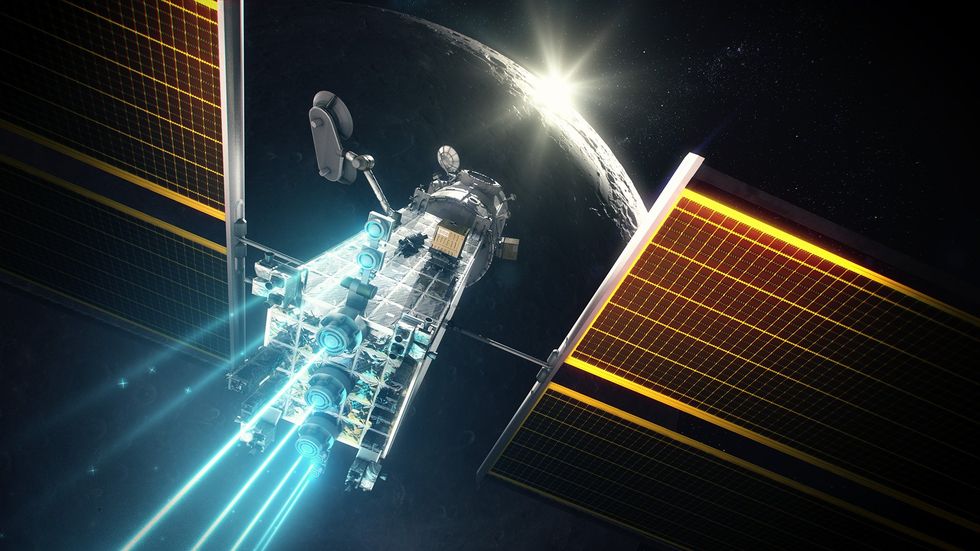
PPE’s two large rollout solar arrays, each the size of NFL end zones, will generate the energy that will ionize and accelerate xenon gas in an electric propulsion system. HALO’s fabrication and testing is nearing completion in Italy. PPE’s primary structure is being tested in Palo Alto, Calif., and the electric propulsion thrusters are being tested in Cleveland. HALO and PPE are scheduled to launch on a SpaceX Falcon Heavy rocket in November 2025.
The 10,000-kilogram International Habitat (I-HAB) is an ESA contribution, being developed by prime contractor Thales Alenia Space, with contributions from Japan in the form of the Environmental Control and Life Support System. I-HAB will provide a habitable volume of 10 cubic meters.
Another module, the European System Providing Refueling, Infrastructure and Telecommunications (ESPRIT), will have two parts. The first—the HALO-Lunar Communication System—will launch with the HALO. The second, the ESPRIT Refueling Module, will be a habitable element along with pressurized fuel tanks and docking ports. It is slated to launch in 2029 with Artemis V.
Dettmann described several major challenges in developing the ESPRIT, including devising a way to refuel the electric propulsion systems, designing deployable radiators, and devising environmental-control and life-support systems.
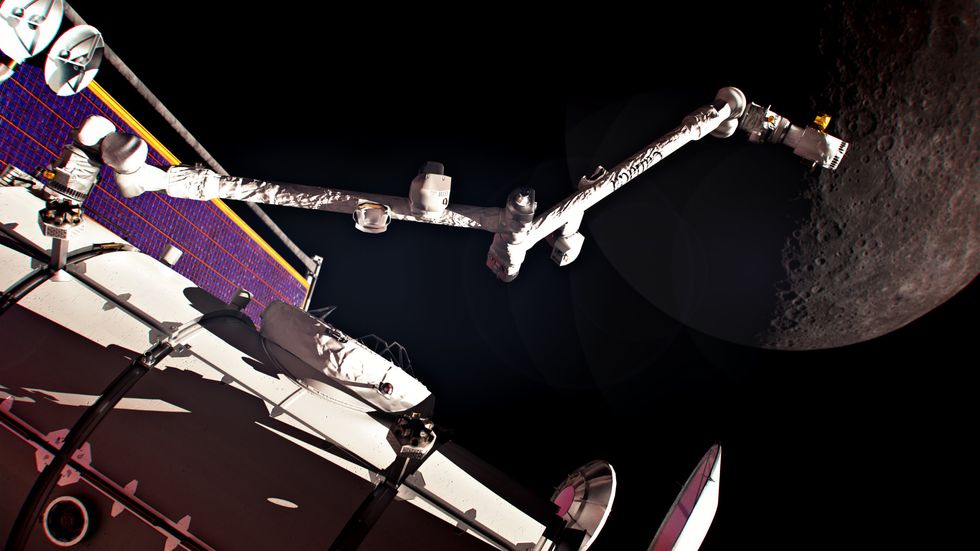
The Gateway External Robotics Systems—provided by the Canadian Space Agency and featuring the Canadarm3 robotic arm manipulator, a more autonomous version of the Canadarm2 used on the International Space Station—will help maintain, repair, and inspect Gateway, while also capturing visiting spacecraft. It will launch with Artemis V. Artemis VI, scheduled for 2030, will deliver Gateway’s airlock module, which will provide transfer capabilities for crew and science payloads.
Vehicle System Manager software will allow Gateway to operate autonomously when not crewed, which will be the case for at least nine months each year. The station will orbit in a complex, seven-day, highly elliptical trajectory that will take it 1,500 km over the moon’s north pole before swinging out as high as 70,000 km above the south pole. The stability of this orbit reduces fuel consumption and thus cuts costs. And, more important, it gives the station extended periods to directly view the south pole, where shadowed craters appear to shield deposits of ice. Mission planners are hopeful that the water ice exists in quantities sufficient to be a useful source of hydrogen and oxygen for fueling rockets. The first Artemis astronauts will enter Gateway on the Artemis IV mission, some time after September, 2028. The mission’s rocket will launch both an Orion spacecraft and the I-HAB, which will dock with Gateway. The astronauts will then head to the lunar surface on SpaceX’s Human Landing System.
Gateway is designed to operate for at least 15 years. In the more distant future, Gateway could be used to assemble a separate spacecraft for long-duration missions to Mars. But such missions face many immense challenges, any one of which could prove to be a showstopper. Besides the problems of deep-space flight, there are the dizzying expenses of developing the key platforms, along with question marks over the sustainability of the Space Launch System.
Much more manageable are the series of robotic moon missions planned starting in 2024, highlighting the diversification of interest in the moon. In May, China will attempt to send a multistage spacecraft to grab the first-ever samples from the lunar far side. Chang’e-6 aims to collect 2 kilograms of material from the intriguing South Pole-Aitken Basin, including material excavated from the moon’s mantle. It will be supported by a communications relay satellite named Queqiao-2. Because earthbound observers can directly view only the near side of the moon, Queqiao-2 will have to bounce signals between Chang’e-6 and Earth.
There will also be commercial missions, with U.S. firms Astrobotic Technology, Firefly Aerospace, and Intuitive Machines, planning to send a variety of spacecraft to the moon as part of NASA’s Commercial Lunar Payload Services program, working on much smaller budgets than the tens of billions being spent on SLS, Orion, and Gateway.
Japan’s SLIM lander launched in September 2023 and will attempt to land in January 2024. Japanese commercial firm Ispace will make its second attempt to land on the moon with the Hakuto-R Mission 2. Finally, a mission that would gain serious attention is a potential SpaceX uncrewed demo of its Starship Human Landing System late in the year; a spacecraft integral to the Artemis III landing.
A new era of exploration is at hand. Astronauts will push into deep space. Human habitations will orbit distant planets. They will wring fuel from primeval ice. And their journey begins this year, with a return to the moon.
This article appears in the January 2024 print issue as “Back to the Moon, Almost .”
- Can the Artemis Moon Mission Revive the Glamour of Big Tech? ›
- China’s Moon Missions Shadow NASA Artemis’s Pace ›


